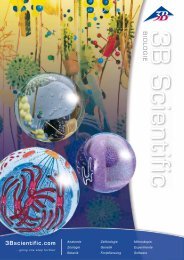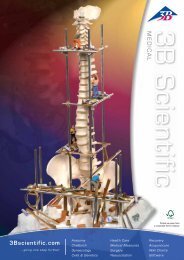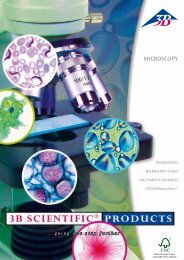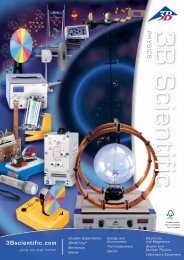3B Scientific - Biology Catalog
3Bscientific.com
3Bscientific.com
Create successful ePaper yourself
Turn your PDF publications into a flip-book with our unique Google optimized e-Paper software.
Zoology in the Classroom<br />
Morphology, the study of the structure of organisms and of the relationship among their constituent<br />
organs, together with taxonomy, the science dealing with the relationships among organisms and<br />
their classification into a hierarchical system, are closely associated. Without morphology and taxonomy,<br />
biology could not be conducted in a meaningful way. When taught separately, both are tedious<br />
subjects for nearly every student. But if the teacher puts structure, function and relationship into a<br />
meaningful context, analyzes these factors and shows how a taxonomic unit propagates throughout<br />
the available habitats, i.e. when radiation takes place, and when it finally becomes evident that a certain<br />
“blueprint” has been “invented”, these otherwise dry subjects gain life and become interesting.<br />
This CD offers some interesting insights into some problems regarding structure and function within<br />
the context of animal taxonomy. The CD contains a wealth of colour photographs, illustrations and<br />
detailed diagrams of basic body structures of the animal classes, as well as micro and macrophotographs<br />
that may be enlarged to full-screen size or printed at the touch of a button.<br />
9982-1004292<br />
The Wonder of the Plant Cell<br />
Few things in living nature are so multifaceted as the forms that plant cells can adopt. Depending<br />
on their function, they can be symmetrical and smooth-walled filling cells, repeatedly-branched trichomes,<br />
star-shaped, ring-shaped, corkscrew-shaped or reticular vessel cells, shut-off cells, storage<br />
cells with substances including crystals, woody cells, pollen cells with superficial features characteristic<br />
to each plant, etc. Even the leafless plants stand out for their multiplicity of forms: unicellular and<br />
multicellular green algae, blue algae, golden algae, fire algae, and particularly the diatomea, with<br />
their wildly varying shell forms possessing a remarkable aesthetic appeal.<br />
9982-1004293<br />
Botany in the Classroom<br />
The purpose of this CD is the same as that of CD 9982-1004292, but focused on botany. Plant derived<br />
foodstuffs form the basis of human nourishment. Given that modern students enjoy ever diminishing<br />
opportunities to observe or take part in sowing, cultivating, harvesting and utilization of crops, this<br />
CD attempts to fill that void. The most important crops are listed, noting their flowering periods in<br />
Roman numerals. Pictures of plants and data on their provenance, history, cultivation and utilization<br />
provide the teacher a wealth of material for a varied and interesting botany lesson.<br />
9982-1004294<br />
<strong>Biology</strong> of Flowers and Fruits<br />
One of the identifying features of higher plants is the occurrence of flowers and fruits, whose complex<br />
structure under the microscope makes for interesting observations. Some plants, such as conifers,<br />
build male and female germinal elements in different flowers. The formation of seeds and fruits is<br />
determined by the different modes of dispersal, such as by means of edible fruit flesh or of dehydration-resistant<br />
grains. Flower biology or ecology examine and describe the interactions occurring in the<br />
pollination process between flowers and their non-living and living environment. Among the external<br />
forces that make pollen dispersal possible are wind, water and transportation by animals. Of these<br />
three, pollination through animals ranks as the uppermost method, being the most effective and<br />
common of all.<br />
9982-1004295<br />
Software<br />
Crop Pests and Controls<br />
Since man started to practice agriculture, he had to ”defend“ his crops against damaging organisms.<br />
Often, a large part, if not all, of a harvest is lost to harmful plants or pests, mostly caused by different<br />
types of fungi. For their multiplication and propagation, these fungi produce colossal amounts of extremely<br />
resistant spores. Exact knowledge of the way of life of these harmful plants is necessary to<br />
combat them effectively. The pictures, showing crops affected by pests, will be of interest to hobby<br />
gardeners and farmers alike. The CD deals also with a very promising aspect of global environmental<br />
protection: biologic pest control. Using well known, easy to follow examples, the subject is explained<br />
and its goal made more accessible.<br />
9982-1004296<br />
170 <strong>3B</strong> <strong>Scientific</strong>® <strong>Biology</strong>















